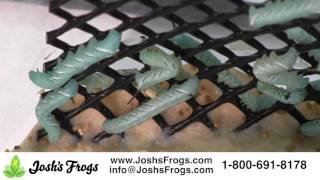
Now, you might be wondering, “What kind of predators are we talking about here?” Well, we’re mainly looking at beneficial insects like lacewings, certain wasps, and even birds that love munching on hornworms. By creating a hornworm-friendly habitat for these predators, you’re not only protecting your plants but also promoting biodiversity. Let’s dive into how you can set up this haven, step by step.
Understanding the Hornworm Problem
Hornworms, particularly the tomato hornworm, are notorious for their ability to devour tomato plants and other nightshades. They blend into the foliage, making them hard to spot until they’ve caused significant damage. If left unchecked, a single hornworm can strip a plant bare in just a few days! So, rather than resorting to chemical pesticides, which can harm beneficial insects, why not look to nature for a solution?
One key to managing hornworm populations is understanding their life cycle. Hornworms start as eggs laid on the undersides of leaves. Once they hatch, they begin feeding voraciously. In their larval stage, they can grow quite large, making them an easy target for various predators. By promoting a habitat for these predators, you can help keep hornworm populations in check.
Choosing the Right Location
The first step in creating a hornworm-friendly habitat is picking the right spot in your garden. You want an area that offers shelter, food sources, and a little bit of sun. Try to find a location that:
- **Has some shade** to protect the predators from intense sunlight.
- **Is close to existing plants** they can easily hide in or feed on.
- **Receives some moisture** so that beneficial insects like ladybugs and lacewings can thrive.
You might be thinking, “Can’t I just put this anywhere?” Well, sure, but consider how the location affects sun exposure and protection from wind. A well-placed habitat can make all the difference in attracting those helpful critters.
Planting Beneficial Flora
To attract predators, you’ll want to include a variety of plants in your garden that serve as food sources or shelter. Think of these plants as a buffet for the beneficial insects you want to encourage. Here are some excellent options:
- **Nasturtiums:** Their bright flowers not only beautify your garden but also attract aphids, which are a food source for ladybugs.
- **Fennel and dill:** These herbs attract parasitic wasps that lay their eggs in hornworms.
- **Marigolds:** They can repel certain pests and draw in beneficial bugs.
By planting these varieties, you’re effectively creating a buffet that attracts hornworm predators, ensuring they have plenty to feast on. Plus, this brings in a delightful pop of color to your garden!
Creating Shelter and Nesting Sites
Predators need a safe space to hide from the elements and establish their homes. Think about adding features like:
- **Brush piles:** They offer shelter for various beneficial insects.
- **Insect hotels:** These structures can house solitary bees and other helpful bugs.
- **Diverse plant heights:** Taller plants can provide cover, while shorter ones offer easy access to the ground.
Here’s the thing: Even the tiniest changes can make a big impact. If you can create spaces where predators feel secure, they’re more likely to stick around and munch on those pesky hornworms!
Water Sources for Your Predators
Just like us, insects need water to survive. Providing a small water source can make your garden a prime destination for predators. You don’t need a massive pond; even a birdbath or shallow dish filled with water will do. Here’s how to set it up:
1. **Choose a shallow dish.** Make sure it’s wide enough for insects to land on but shallow enough to avoid drowning.
2. **Add pebbles or marbles.** This gives insects a safe landing spot and keeps them afloat.
3. **Place it in a sunny spot.** Predators are more likely to visit a water source where they can bask in the sun.
A water source adds an inviting element to your habitat, encouraging predators to come by more often.
Maintaining Your Habitat
Creating a thriving environment for hornworm predators isn’t just a one-and-done project. Maintaining it is equally important, and you might be asking, “What does that entail?” Here are some tips to keep your habitat flourishing:
- **Regularly check plants:** Monitor for hornworm activity while also keeping an eye on the health of your beneficial plants.
- **Avoid pesticides:** Chemicals will not only harm pests but also your helpful insects. Stick to organic methods where possible.
- **Rotate plants yearly:** This helps to prevent pest buildup and keeps the habitat dynamic.
You might find that a little effort goes a long way. Over time, you’ll see more beneficial predators taking up residence, leading to fewer hornworms!
Embracing Biodiversity in Your Garden
Creating a hornworm-friendly habitat isn’t just about dealing with pests; it’s also about embracing the broader concept of biodiversity. When you support various beneficial insects and animals, you’re fostering a balanced ecosystem right in your backyard. This can lead to a healthier garden overall, as natural predators help control not just hornworms but other pests too. Plus, think of the joy in observing these little creatures at work!
You might be wondering if there’s a downside to all this. Honestly, the only downside could be getting attached to the beauty and complexity of your little ecosystem! But if you’re dedicated to nurturing it, the rewards are well worth it.
In conclusion, creating a hornworm-friendly habitat for predators can transform the way you manage pests in your garden. By choosing the right location, planting beneficial flora, providing shelter, and maintaining the habitat, you’re set to invite a wide range of helpful insects into your garden. Embrace the process and enjoy the wonders of nature working alongside you. Happy gardening!
